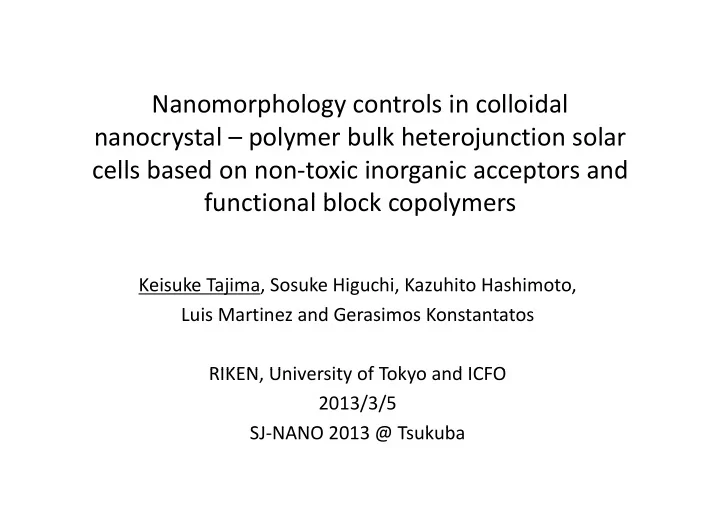

Nanomorphology controls in colloidal nanocrystal – polymer bulk heterojunction solar nanocrystal – polymer bulk heterojunction solar cells based on non-toxic inorganic acceptors and functional block copolymers functional block copolymers Keisuke Tajima, Sosuke Higuchi, Kazuhito Hashimoto, Luis Martinez and Gerasimos Konstantatos Luis Martinez and Gerasimos Konstantatos RIKEN, University of Tokyo and ICFO RIKEN, University of Tokyo and ICFO 2013/3/5 SJ-NANO 2013 @ Tsukuba SJ-NANO 2013 @ Tsukuba
Organic Solar Cells e - LUMO LUMO ITO e - h v Al Al ITO ITO h + Al HOMO Bulk heterojunction structure Bulk heterojunction structure Donor Acceptor Hiramoto et al., Appl. Phys. Let., 1991 , 58 , 1062. Yu et al., Science 1995 , 270 , 1789. Donor (p-type) Acceptor (n-type) Advantages Advantages Low cost, Flexibility, Light weight PCBM PCBM P3HT
Hybrid Solar Cells ・ Weak Absorption in Visible ・ Weak Absorption in Visible ・ Poor Electron Mobility PCBM Hybrid Solar Cells Hybrid Solar Cells Inorganic Materials as Electron Acceptors e - h n e - LUMO Advantages CB ・ Absorption of visible light ・ Absorption of visible light Al Al ITO ITO HOMO ・ High electron mobility h + VB h + Donor Acceptor (Organic) (Inorganic)
Hybrid Solar Cells CdSe tetrapod CdSe tetrapod 5 nm 30~50 nm PCPDTBT (Low bandgap polymer) 50 nm PCE : 3.13 % PCE : 3.13 % Absorption of CdSe Highest PCE in polymer/nano particle hybrid solar cells Dayal, et al., Nano Letters 2010 10 (1), 239-242
Bismuth Sulfide (Bi 2 S 3 ) 10 nm 10 nm ・ Non-toxic (Cd, Pb have toxicity) ・ Non-toxic (Cd, Pb have toxicity) ・ Band gap: 1.3 eV (CB: -4.3 eV, VB:-5.6 eV) -Strong absorption in near IR region → Contribution to light harvesting → Contribution to light harvesting Good n-type Material Good n-type Material for Environmental Friendly Hybrid Solar Cells Hybrid Solar Cells
Polymer : Bi 2 S 3 device (Bilayer) (From ICFO group) V oc = 0.32 V J sc = 3 mAcm −2 FF = 49% FF = 49% PCE = 0.46% Martinez, L.; Konstantatos, G., Adv. Ener. Mater., 2011, 1 , 1029. Martinez, L.; Konstantatos, G., Adv. Ener. Mater., 2011, 1 , 1029. Bulk heterojunction device
Problem of Bulk Heterojunction Device Device structure Cross sectional SEM image of BHJ device Cross sectional SEM image of BHJ device Ag Ag Bi 2 S 3 NPs MoO 3 Top P3HT layer P3HT P3HT Blend of P3HT and Bi2S3 Bi 2 S 3 layer (Hole blocking layer) (Hole blocking layer) ITO Very Poor Mixing between Bi 2 S 3 NPs and P3HT Very Poor Mixing between Bi 2 S 3 NPs and P3HT Small D/A interface area limits its efficiency Small D/A interface area limits its efficiency → PCE : ~0.7% Need to control morphology in BHJ device Need to control morphology in BHJ device By interactions between functional polymers and NPs
Thiol Containing Block Copolymer S S block n m SH-P3HT SH Expectation Thiol groups NPs h + h P3HT e - Interactions in Solution Self-assembled Functional P3HT Small D/A Domains Small D/A Domains S S S l m n This Idea Stems from Our Previous Work This Idea Stems from Our Previous Work N N O O N O N Miyanishi et al. Macromolecules , 2012 , 45 , 6424 Fullerene attached block copolymer
Discussions By attaching NPs through thiol group, By attaching NPs through thiol group, packing of P3HT might be disturbed SH-P3HT domain has poor crystallinity SH-P3HT domain has poor crystallinity Reasons of V OC increase and J SC decrease ・ Worse packing of polymer ・ Worse packing of polymer ・ Isolation of NPs LUMO LUMO Lower HOMO Bad charge transport pathway V OC h + increase HOMO J SC ↓ Lower HOMO V OC ↑ Worse packed P3HT Amount of thiol groups seem too much Use blend of normal P3HT and SH-P3HT or less thiol containing SH-P3HT
Summary • Thiol Functionality Significantly Improved Morophology in • Thiol Functionality Significantly Improved Morophology in NPs/Polymer Blend Films. • Controlling Degree of Aggregation by Mixing P3HT and SH-P3HT Enhanced PCE to Close to 1 %. S S block h + m m n n SH e - SH-P3HT Use of Functional Block Copolymer Is A Promising Approach To Control Morophology of Hybrid Solar Cells
Recommend
More recommend